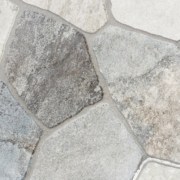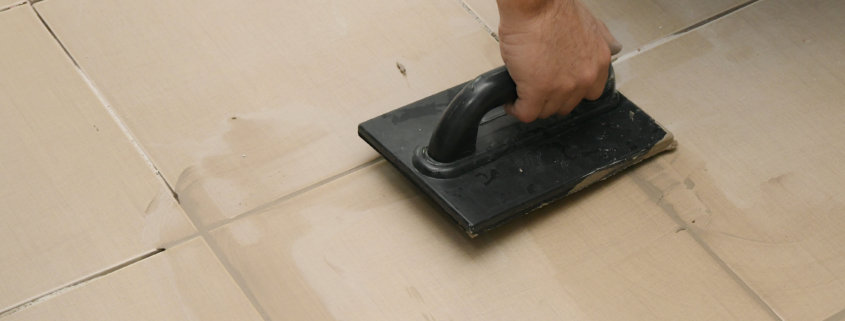Grout for natural stone tiles
Choosing the right type of grout for natural stone tiles
In a natural stone tiling project, once the tiles are put in place using tile glue, the gaps between the tiles must be filled and sealed. This is done by applying a grout for natural stone tiles. The purpose of the grout is to seal and fill the caps, but also to make the seams impermeable to water to prevent liquids seeping to the tile glue layer. The grout also holds the tiles in their place and creates a supportive network over the tiled area.
Especially when working with natural stone tiles, choosing the right grout for tiling is of high importance. The wrong choice of grout may lead to ruined looks of the tiling or failure of the tile installation, in the worst case. So how to choose the best grout for natural stone tiles? Generally, you can’t go wrong if you keep in mind that the tile or stone, adhesive and grout all need to be compatible with each other. However, it is not always that simple. Here you will find some considerations regarding grout for natural stone tiles as well as the most common types of grout.
What to consider when choosing a grout for natural stone tiles?
Natural stone tiles are known to be rather difficult to work with due to their sensitive nature, possibly light colour and porous structure. Some factors that affect the choice of grout for natural stone include the following:
- Gap width: some tile grouts are designed for wide gaps whereas others can only be applied in narrow gaps due to shrinkage.
- Hardness of the tile: if the tile has a shiny or extremely soft surface, some grout types may actually scratch the surface, ruining the looks.
- Porosity of the tile: very porous tiles may become stained by the grout. Fortunately this problem can be overcome by protecting the tiles with a sealer or grout release substance prior to grouting.
- Tile color: when working with tiles that require a grout of a certain color, some grout options are available. Not all of them come in colors other than white and grey.
- Tiling location: one must also consider whether the tiling is applied horizontally or vertically, indoors or outdoors, in a high foot traffic area such as a hallway or less used areas such as bathrooms.
The types of grout suitable for natural stone tile installations
Just as there are many types of natural stone tiles (such as granite, marble, slate, limestone etc.) and adhesives, there are various types of grout. The types of grout can generally be divided into cementitious and non cementitious, of which the most common in North America is epoxy. Here we introduce the most popular grout types for natural stone tiles.
Cementitious grout / mortar
The oldest and still by far the most popular grout, also in the US and Canda, is cementitious grout which uses Portland cement as its main ingredient. The other ingredients include filler particles of different sizes and materials depending on whether the grouting system is sanded or non sanded, a water retentive additive and pigments that create the color. It is also possible to strengthen the cementitious grouts by adding ingredients such as latex.
The cementitious grout, also known as mortar, comes in a form of a powder which is mixed with water prior to application. After mixing, the mortar should be let stand for 10 minutes and then be mixed again to make sure no dry material remains in the mixture. The mixing should always be done by hand rather than with electrical equipment.
Cementitious grout exists as sanded and non sanded variations which can both be applied to natural stone tiling. It is important to keep in mind that mortar seams need regular cleaning and sealing due to their somewhat porous nature which makes them prone to dirt and staining.

Sanded cementitious grout
Sanded cementitious grout, as the name implies, contains sand. The sand in the systems makes it stronger and prevents cracking. Therefore, suitable for wider gaps. The general rule is that sanded mortar should be used when the gap width is ⅛ inch or wider. When working with natural stone tiles, it is important to keep in mind that the sand can actually scratch the surface of the tile. Always test the grout on a sample tile to guarantee compatibility.
Non sanded cementitious grout
The non sanded grout has much smoother a texture than sanded grout. Non sanded grout contains mineral particles that are very fine and do not provide a grit structure. Also non sanded grout is common for natural stone tiling, however, it may stain the tile if the tiles are not protected by a sealer prior to grout application.
Non sanded grout is ideal for narrow seams from 1/16 inch to 1/8 inch. This because of the fact that non sanded grout shrinks as it cures. When applied to wide seams, more mortar is used hence the shrinkage is greater making the grout pull away from the tiles.
Latex modified sanded grout
It is possible to increase the performance of sanded cementitious grout by adding a latex polymer. The polymer can be added into the grout powder or as a liquid while mixing the powder with water. The addition of latex polymer remarkable improves the waterproof properties of sanded grout.
Epoxy grout
If you are looking for the best grout for natural stone tiles, epoxy grout makes a good candidate. However, it is also the most expensive type of grout and not always worth the investment. Nevertheless, epoxy grout is the strongest option available, and it is completely impermeable. Epoxy grout consists of epoxy resin, silica fillers, pigments and a hardener. The systems can be two or three component grouts. Natural stone tiles should be sealed prior to grouting to avoid staining.
Also epoxy grout comes as sanded and non sanded variations, yet the sand is not the same kind of sand as used in mortar. Both types of epoxy grout are resistant to water as well as chemicals making them ideal for areas such as kitchens. Even though epoxy may seem like a perfect solution, the application requires expertise as epoxy grout cures fast compared to cementitious grouts. Once the components have been mixed, the curing process starts.
TIP: after mixing the components, divide the grout in two containers and put one of them in the freezer. The low temperature slows down the curing process giving you extra time to finish grouting.
As epoxy grout forms impermeable seams, it is not necessary, nor recommended to seal the grout. In case the grout shows signs of dirt or staining, it is best cleaned using vinegar or bleach and water.
Epoxy hybrid grout
Epoxy can also function as a ingredient of a hybrid grouting system. Most commonly epoxy grout is reinforced with Portland cement. This hybrid results in seams similar to those made with cementitious grout. They require regular sealing but are stronger, harder and more stain resistant than regular mortar.
Looking for the perfect grout for natural stone tiles?
As natural stone tile require special precautions when choosing the grout, it is not always an easy job to find the best solution. If you are working with natural stones of any kind, and require a grouting systems, contact us: we determined to find the perfect grout for natural stone tiles in your project!



